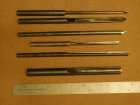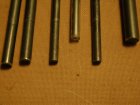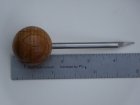Today I needed to use my small spindle gouge for about a minute. All of my handles had other blades in them. Instead of taking the time to remove a blade from a handle and insert my spindle gouge I just held the gouge blade in my hands. It worked well. Without a handle are there safety concerns with holding the blade in my hands?
-
December 2025 Turning Challenge: Single Tree! (click here for details) -
Congratulations to Bob Henrickson, People's Choice in the November 2025 Turning Challenge (click here for details) -
Congratulations to Steven Gordon for "Dropped Ice Cream Cone" being selected as Turning of the Week for December 8, 2025 (click here for details) -
Welcome new registering member. Your username must be your real First and Last name (for example: John Doe). "Screen names" and "handles" are not allowed and your registration will be deleted if you don't use your real name. Also, do not use all caps nor all lower case.
You are using an out of date browser. It may not display this or other websites correctly.
You should upgrade or use an alternative browser.
You should upgrade or use an alternative browser.
Using a gouge blade without handle?
- Thread starter Jesse Tutterrow
- Start date
I think that would be dangerous. Take a minute and swap handles with another tool.
- Joined
- Apr 27, 2004
- Messages
- 9,303
- Likes
- 6,058
- Location
- Lakeland, Florida
- Website
- www.hockenberywoodturning.com
Interesting question.
I’m sure most experiecened turners have used tools without a handle and some may use a particular tool unhandled for its whole life.
If you have sufficient skill to control the tool and not get catches i don’t see any real safety issue for a round bar spindle gouge. A spindle gouge with a tang at least cover the tang with tape to avoid getting cut.
I think you will find unhandled tools more tiring to use. The handle is easier on the hand and makes it easier to roll the tool.
Also bowl gouges are not too useful with out a handle.
Shearscrape I don’t need a handle.
Other cuts I want the handle resting on the thigh, hip, or side to succeed.
I’m sure most experiecened turners have used tools without a handle and some may use a particular tool unhandled for its whole life.
If you have sufficient skill to control the tool and not get catches i don’t see any real safety issue for a round bar spindle gouge. A spindle gouge with a tang at least cover the tang with tape to avoid getting cut.
I think you will find unhandled tools more tiring to use. The handle is easier on the hand and makes it easier to roll the tool.
Also bowl gouges are not too useful with out a handle.
Shearscrape I don’t need a handle.
Other cuts I want the handle resting on the thigh, hip, or side to succeed.
Last edited:
Odie
Panning for Montana gold, with Betsy, the mule!
I agree with Al on this......
It mostly depends on who is using the unhandled tool.....because it all depends on how skillfully it's used, and not the tool itself.
I would not recommend it for a novice.....
-----odie-----
It mostly depends on who is using the unhandled tool.....because it all depends on how skillfully it's used, and not the tool itself.
I would not recommend it for a novice.....
-----odie-----
I agree with Al. Skill, control and craftiness all have to be considered. Here are some of the tools I sometimes use unhandled, the one with the tyvec tubing
is, I guess, technically handled but small enough to be almost not there. The ends have been chamfered a bit to feel more comfortable in the hand. Safety wise, these are used for small stuff mostly but definitely used with very little overhang.


cc
Edited to add; Sometimes the smaller tools are more nimble without a handle.
is, I guess, technically handled but small enough to be almost not there. The ends have been chamfered a bit to feel more comfortable in the hand. Safety wise, these are used for small stuff mostly but definitely used with very little overhang.


cc
Edited to add; Sometimes the smaller tools are more nimble without a handle.
- Joined
- Apr 1, 2015
- Messages
- 603
- Likes
- 450
- Location
- Sitka, Alaska, United States
- Website
- www.zachlaperriere.com
I can imagine that a normal catch could potentially send the tool flying. This isn't for beginners, or for any cut that cannot be controlled with light pressure—which means only lighter cuts.
I mainly use unhandled tools for tight quarters in sheer cuts. Again: it's potentially dangerous, so not recommended, and only with a light touch for sheer cuts.
One rule of thumb I have for sheer cuts with unhandled tools: I keep my hands a little above the bottom end of the tool. In a sheer cut, there's a special kind of catch: going off the edge of the tool rest. This causes the tool to go straight down, and if the banjo or lathe bed is in the way: serious trouble. Especially if your hand is between the tool and something hard. I suspect you could send the tool right though a hand in this sort of mishap.
I mainly use unhandled tools for tight quarters in sheer cuts. Again: it's potentially dangerous, so not recommended, and only with a light touch for sheer cuts.
One rule of thumb I have for sheer cuts with unhandled tools: I keep my hands a little above the bottom end of the tool. In a sheer cut, there's a special kind of catch: going off the edge of the tool rest. This causes the tool to go straight down, and if the banjo or lathe bed is in the way: serious trouble. Especially if your hand is between the tool and something hard. I suspect you could send the tool right though a hand in this sort of mishap.
- Joined
- Jan 27, 2005
- Messages
- 13,177
- Likes
- 5,752
- Location
- Dalworthington Gardens, TX
- Website
- pbase.com
While I wouldn't consider using a skew or parting tool without a handle, I have used a bowl gouge and a detail gouge without a handle a few times. I probably wouldn't try to make an entry cut at the rim of a large bowl or a natural edge bowl, but other than not being able to use your body to smoothly steer the tool, the tool can be easily controlled with very light finger control.
I was taught to never use a file (on a metal lathe) for chamfering an edge unless the file has a handle. It can easily catch and shove the tool’s tang back into the operator’s hand or gut.
I have to believe that a woodworking gouge has to be more dangerous.
Safe practices should never be skipped.
Rich
I have to believe that a woodworking gouge has to be more dangerous.
Safe practices should never be skipped.
Rich
Based on my training, it is safe if the tool can’t easily be shoved into your body. I’d say that ball probably meets that need.
By the way, where did you get the golden ratio (phi) ruler ?
By the way, where did you get the golden ratio (phi) ruler ?
I got mine from Lee Valley.
The handle for any tool used determines the ergonomics on your body during the time it is being used. A hardened steel tool exposes your hand and joints to vibrations that can cause muscle fatigue and nerve damage. An ergonomic size/shaped handle can reduce these stresses/forces on the body when these tools are used for extended periods of time. Many of the medical problems people have problems with are from accumulative effects of poor habits we expose our bodies to over time. Carpal Tunnel Syndrome, Arthritis, Nerve Damage can all be caused by poor ergonomic habits over time.
Yep, Lee Valley...
http://www.leevalley.com/us/wood/page.aspx?p=57625&cat=1,43513,57625
http://www.leevalley.com/us/wood/page.aspx?p=57625&cat=1,43513,57625
- Joined
- Feb 6, 2010
- Messages
- 3,454
- Likes
- 2,522
- Location
- Brandon, MS
- Website
- threeringswoodshop.square.site
The handle for any tool used determines the ergonomics on your body during the time it is being used. A hardened steel tool exposes your hand and joints to vibrations that can cause muscle fatigue and nerve damage. An ergonomic size/shaped handle can reduce these stresses/forces on the body when these tools are used for extended periods of time. Many of the medical problems people have problems with are from accumulative effects of poor habits we expose our bodies to over time. Carpal Tunnel Syndrome, Arthritis, Nerve Damage can all be caused by poor ergonomic habits over time.
Have to be the one to tell you that arthritis is not the result of poor habits or exposure over time although time in our body (age) can contribute
Gerald,
I beg to differ if you have ever known someone that has worked physically demanding jobs with repetitious movements of the body this can cause arthritic swelling and pain in later years. There are a variety of ailments that may be miss-termed as arthritic, but not being able to walk without pain or able to use your hands without pain and difficulty would be considered arthritic by most people. I work with a large number of people in the industrial trades and most of them have arthritic conditions after working 30-40 years in physically demanding trades. Working outdoors in cold weather can also have a contributing effect on arthritic type conditions for many of these individuals. Prolonged exposure to severe cold can cause bone calcification problems in joints and ligaments and repetitive impacts to joints and bones can also increase the bone calcification process.
Back to the original question, basic ergonomics advises not to use hard handled tools for repetitive tasks as this can cause damage to nerves and soft tissues in the hand. A rotating billet of wood turning at a 1000 RPM's can impart a large amount of repetitive stresses to the hand if you are encountering a knot in the wood. Try operating a jack hammer for several hours and see if you have any nerve or joint pain in your hands, arms, shoulders and back.
I beg to differ if you have ever known someone that has worked physically demanding jobs with repetitious movements of the body this can cause arthritic swelling and pain in later years. There are a variety of ailments that may be miss-termed as arthritic, but not being able to walk without pain or able to use your hands without pain and difficulty would be considered arthritic by most people. I work with a large number of people in the industrial trades and most of them have arthritic conditions after working 30-40 years in physically demanding trades. Working outdoors in cold weather can also have a contributing effect on arthritic type conditions for many of these individuals. Prolonged exposure to severe cold can cause bone calcification problems in joints and ligaments and repetitive impacts to joints and bones can also increase the bone calcification process.
Back to the original question, basic ergonomics advises not to use hard handled tools for repetitive tasks as this can cause damage to nerves and soft tissues in the hand. A rotating billet of wood turning at a 1000 RPM's can impart a large amount of repetitive stresses to the hand if you are encountering a knot in the wood. Try operating a jack hammer for several hours and see if you have any nerve or joint pain in your hands, arms, shoulders and back.
I frequently use NRSs (negative rake scrapers) without handles. ALWAYS with the tool rest very close to the work. More of a leverage thing than anything else. Hang out too far for the amount on the other side of your tool rest/fulcrum and you are inviting trouble. Dainty cuts for sure... Your grip might be more difficult due to small shaft diameter...
robo hippy
robo hippy
- Joined
- Jan 27, 2005
- Messages
- 13,177
- Likes
- 5,752
- Location
- Dalworthington Gardens, TX
- Website
- pbase.com
I found some good general information about arthritis on Medical News Today.
Just the thought of using any tool without a handle gives me the Heebie Jeebies.
Rude Osolnik had a favorite tool (Spindle skew gouge) he would make himself from rectangular HSS and he would use it without a handle, he did pretty nice work and lots of it.
Turned for many years and his Candle stick is/was a famous turning.
I have used unhandlet tools, but rather use handler ones, but yes they can be used safely if you know what you are doing IMO

Turned for many years and his Candle stick is/was a famous turning.
I have used unhandlet tools, but rather use handler ones, but yes they can be used safely if you know what you are doing IMO

Odie
Panning for Montana gold, with Betsy, the mule!
I got mine from Lee Valley.
How is a PHI ruler used?
edit:
Thanks, Clifton.....
The link you provided here, helps to answer my question:
-----odie-----
Last edited:
- Joined
- Jan 27, 2005
- Messages
- 13,177
- Likes
- 5,752
- Location
- Dalworthington Gardens, TX
- Website
- pbase.com
How is a PHI ruler used? ...
The Greek letter φ (phi) is commonly used as the mathematical symbol for the golden ratio in honor of the Greek architect Pheidias.
Odie, years ago I found plans for a golden ratio caliper and knew my prayers had been answered. I made a christmas ornament where every part was related in a phi way to every other part, ugliest looking thing I have ever turned... I've since learned that phi has it's place but is not the end all be all. I don't turn with phi caliper or rule in hand, but, after I've turned a piece that is a bit better then the rest, I find phi related measures, such as height to width or base diameter to rim diameter or where a bead is placed, then I'm left to wonder, is it a coincident or not?
- Joined
- Apr 1, 2015
- Messages
- 603
- Likes
- 450
- Location
- Sitka, Alaska, United States
- Website
- www.zachlaperriere.com
That's very cool Clifton. A talented woodworker I respect greatly said of the Golden Ratio: "It's like gold: you gotta know where to use it and where not, but you wouldn't want to use it everywhere. Just imagine a gold airplane..."
Can't say I know where to use it, but I get it that it's only sparing in most cases.
Can't say I know where to use it, but I get it that it's only sparing in most cases.
any time I question whether something is safe, I ask myself if I would rather take the time to ....in this case change the handles....or take the time to do the rehab to recoup from the injury.Today I needed to use my small spindle gouge for about a minute. All of my handles had other blades in them. Instead of taking the time to remove a blade from a handle and insert my spindle gouge I just held the gouge blade in my hands. It worked well. Without a handle are there safety concerns with holding the blade in my hands?
I'd probably change the handle.
You could... wait for it.... TURN a handle!!
Ely
Ely

